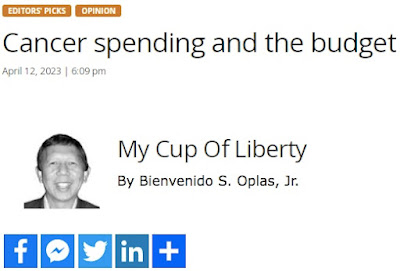Cancer spending and the budget
* BusinessWorld April 12, 2023.
-----------
The Philippine Statistics Authority (PSA) released today an update on causes of deaths in the Philippines for the period January-November 2022. I expanded the data backwards until 2017 so six years and saw some interesting trends.
One, COVID deaths, both with identified and unidentified virus, have shrunk greatly, from 13.8% of total deaths in 2021 — when it was the second biggest cause of death next to ischemic heart diseases — to only 2.8% in 2022.
Two, cancer deaths declined significantly, from 11.1% of the total in 2019 to only 7.8% in 2021, then up to 10.2% in 2022.
Three, pneumonia deaths also declined significantly, from 10.1% of the total in 2019 to only 4.2% in 2021 — wow! It was up to 4.8% in 2022.
Four, lower respiratory plus tuberculosis (TB) deaths combined declined from 7.9% in 2019 to only 4.9% in 2021, then up to 6.1% in 2022 (see the Table).
My suspicion is that the number of COVID deaths were exaggerated — by labeling many deaths from regular pneumonia as COVID pneumonia, even labeling deaths from cancer and TB with COVID as COVID deaths — to justify the horrible dictatorial lockdown of 2020-2021, and the huge cost of COVID vaccine procurement plus logistics of about P88.6 billion in 2021, P45 billion in 2022, and P24.5 billion in 2023.
The reporting of COVID cases and deaths were also incentivized via higher PhilHealth subsidies. For instance, PhilHealth reimbursement of the hospital bill of COVID patients was P100,000+ for mild pneumonia, about P330,000 for severe pneumonia, and P780,000 for critical pneumonia. So, patients and their families would worry less about their hospital bills if a non-COVID case was declared as a COVID case.
Now that COVID-related sickness and deaths have significantly declined, it is time to reprioritize the budget for public health. I checked cancer deaths — the PSA has a breakdown until 2021 only, with no update yet for 2022 — but the data shown in the table is already useful. The top three cancer killers are breast, colon/rectum/anus, and trachea/bronchus/lung cancers.
Cancer treatment is very expensive and for many middle-class households, it can be a poverty-inducing exercise to spend their savings to save a loved one. More so for already poor households.
Now there are moves to expand public spending in cancer treatment and subsidies for poor households, like a bill in Congress creating a Cancer Assistance Fund.
I can support this initiative, it is understandable. But Congress should not further expand the Department of Health and PhilHealth budgets while keeping existing exaggerated spending on other concerns, like COVID vaccination which has topped P150 billion already from 2021 to 2023.
Why? Because of the huge annual budget deficit, the huge public debt, which requires huge annual borrowings to pay old borrowings plus huge interest payments.
The average government financing or borrowings were as follows: from only P73 billion/month in 2019, this jumped to P208 billion/month in 2020, P188 billion/month in 2021, P164 billion/month in 2022, and now, P335 billion/month for January-February 2023.
We need to cut high borrowings, cut high spending, while improving revenue collections and tax administration.
So, while Congressional efforts to expand subsidies for cancer treatment for the poor are understandable, Congress should also cut spending somewhere else.




Comments
Post a Comment